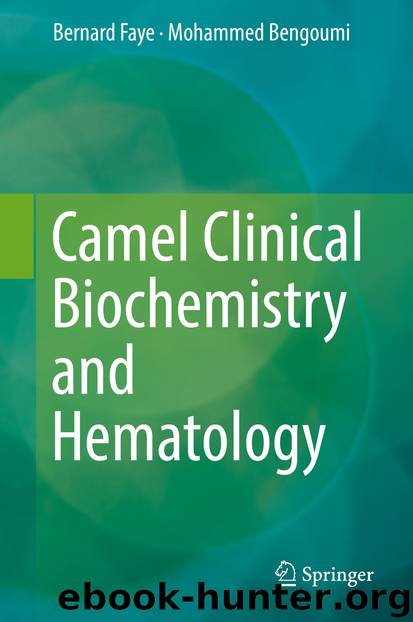Camel Clinical Biochemistry and Hematology by Bernard Faye & Mohammed Bengoumi

Author:Bernard Faye & Mohammed Bengoumi
Language: eng
Format: epub
ISBN: 9783319955629
Publisher: Springer International Publishing
6.2 Biological Signification of Observed Values
The electrolytes play an important role in the osmolality. This aspect being discussed in the first chapter on hematology, the present part will focus on the biological signification of the main electrolytes in camel.
6.2.1 Sodium
Sodium is an electrolyte occurring almost entirely in the fluids of the body where it serves a vital function in controlling osmotic pressures and acid-base balance, maintenance of cell membrane electric potential, and transmission of nerve influx. In a species like camel, particularly well adapted to water restriction, its role in water metabolism is particularly important. Obviously, natremia (as kaliemia) increased significantly during water deprivation (Ghosal et al. 1975). Sodium ions (Na+) constitute 93% of the base ion found in the blood (145 mmol/l in the plasma vs 10–15 mmol/l in cells). It has also some effect on muscle irritability and absorption of carbohydrates. The values are expressed in mmol/l (= mmol/l).
Sodium is mainly absorbed in the small intestine by simple diffusion. Sodium maintenance requirements are estimated at 8 g/100 kg of body weight. Sodium metabolism is mainly regulated by the kidney where an important tubular reabsorption counterbalanced electrically by chloride excretion in the proximal part and with potassium in the distal part of the glomerulus under the control of aldosterone produced by the adrenal cortex which is sensitive to osmolarity occurs. Kidneys are also sensitive to the plasma lower blood pressure, which results in lower filtration rates and activates the renin-angiotensin system. Renin, a peptide hormone produced in the glomeruli, initiates cascade or reactions producing angiotensin II that stimulates production of aldosterone. Antidiuretic hormone (ADH) reduces indirectly sodium concentration by increasing water reabsorption in the kidneys. Plasma sodium concentration is positively correlated to the total sodium content in the body. However, its variations are mainly linked to water distribution in the different hydric sectors. Plasma sodium concentration is the main indicator of plasma osmolarity.
Download
This site does not store any files on its server. We only index and link to content provided by other sites. Please contact the content providers to delete copyright contents if any and email us, we'll remove relevant links or contents immediately.
| Automotive | Engineering |
| Transportation |
Whiskies Galore by Ian Buxton(41880)
Introduction to Aircraft Design (Cambridge Aerospace Series) by John P. Fielding(33064)
Small Unmanned Fixed-wing Aircraft Design by Andrew J. Keane Andras Sobester James P. Scanlan & András Sóbester & James P. Scanlan(32743)
Craft Beer for the Homebrewer by Michael Agnew(18140)
Turbulence by E. J. Noyes(7936)
The Complete Stick Figure Physics Tutorials by Allen Sarah(7307)
Kaplan MCAT General Chemistry Review by Kaplan(6867)
The Thirst by Nesbo Jo(6828)
Bad Blood by John Carreyrou(6552)
Modelling of Convective Heat and Mass Transfer in Rotating Flows by Igor V. Shevchuk(6391)
Learning SQL by Alan Beaulieu(6211)
Weapons of Math Destruction by Cathy O'Neil(6146)
Man-made Catastrophes and Risk Information Concealment by Dmitry Chernov & Didier Sornette(5921)
Digital Minimalism by Cal Newport;(5664)
Life 3.0: Being Human in the Age of Artificial Intelligence by Tegmark Max(5474)
iGen by Jean M. Twenge(5366)
Secrets of Antigravity Propulsion: Tesla, UFOs, and Classified Aerospace Technology by Ph.D. Paul A. Laviolette(5309)
Design of Trajectory Optimization Approach for Space Maneuver Vehicle Skip Entry Problems by Runqi Chai & Al Savvaris & Antonios Tsourdos & Senchun Chai(5011)
Pale Blue Dot by Carl Sagan(4912)
